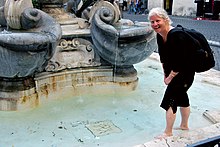
The Torah is the compilation of the first five books of the Hebrew Bible, namely the books of Genesis, Exodus, Leviticus, Numbers and Deuteronomy. In that sense, Torah means the same as Pentateuch or the Five Books of Moses. It is also known in the Jewish tradition as the Written Torah. If meant for liturgic purposes, it takes the form of a Torah scroll. If in bound book form, it is called Chumash, and is usually printed with the rabbinic commentaries.

The Tosefta is a compilation of the Jewish oral law from the late 2nd century, the period of the Mishnah.
The Pharisees were a Jewish social movement and a school of thought in the Levant during the time of Second Temple Judaism. After the destruction of the Second Temple in 70 CE, Pharisaic beliefs became the foundational, liturgical, and ritualistic basis for Rabbinic Judaism.

Torah study is the study of the Torah, Hebrew Bible, Talmud, responsa, rabbinic literature, and similar works, all of which are Judaism's religious texts. According to Rabbinic Judaism, the study is done for the purpose of the mitzvah ("commandment") of Torah study itself.

Shammai was a Jewish scholar of the 1st century, and an important figure in Judaism's core work of rabbinic literature, the Mishnah.

The Sanhedrin was an assembly of either 23 or 71 elders, appointed to sit as a tribunal in every city in the ancient Land of Israel.
Tannaim were the rabbinic sages whose views are recorded in the Mishnah, from approximately 10–220 CE. The period of the Tannaim, also referred to as the Mishnaic period, lasted about 210 years. It came after the period of the Zugot ("pairs"), and was immediately followed by the period of the Amoraim ("interpreters").
According to Rabbinic Judaism, the Oral Torah or Oral Law are statutes, and legal interpretations that were not recorded in the Five Books of Moses, the Written Torah, and regarded by Orthodox Jews as prescriptive and given at the same time. This holistic Jewish code of conduct encompasses a wide swathe of rituals, worship practices, God–man and interpersonal relationships, from dietary laws to Sabbath and festival observance to marital relations, agricultural practices, and civil claims and damages.
The missing years in the Hebrew calendar refer to a chronological discrepancy between the rabbinic dating for the destruction of the First Temple in 422 BCE and the academic dating of it in 587 BCE.
This is a list of books by Jacob Neusner. Articles, reviews, etc. are not included here.
The history of responsa in Judaism, spans a period of 1,700 years. Rabbinic responsa constitute a special class of rabbinic literature, differing in form, but not necessarily in content, from Rabbinic commentaries devoted to the exegesis of the Bible, the Mishnah, the Talmud, and halakha. The codes themselves contain the rules for ordinary incidents of life. The responsa literature covers all these topics and more.
Judith Rebecca Hauptman is an American feminist Talmudic scholar.
Chazal or Ḥazal, an acronym for the Hebrew "Ḥakhameinu Zikhronam Liv'rakha", refers to all Jewish sages of the Mishna, Tosefta and Talmud eras, spanning from the times of the final 300 years of the Second Temple of Jerusalem until the 7th century CE, or c. 250 BCE – c. 625 CE.

Kedoshim, K'doshim, or Qedoshim is the 30th weekly Torah portion in the annual Jewish cycle of Torah reading and the seventh in the Book of Leviticus. It constitutes Leviticus 19:1–20:27. The parashah tells of the laws of holiness and ethical behavior, repeats the ten commandments, and describes penalties for sexual transgressions. The parashah is made up of 3,229 Hebrew letters, 868 Hebrew words, 64 verses, and 109 lines in a Torah Scroll.

Matot, Mattot, Mattoth, or Matos is the 42nd weekly Torah portion in the annual Jewish cycle of Torah reading and the ninth in the Book of Numbers. It comprises Numbers 30:2–32:42. It discusses laws of vows, the destruction of Midianite towns, and negotiations of the Reubanites and Gadites to settle land outside of Israel.
The House of Hillel and House of Shammai were, among Jewish scholars, two schools of thought during the period of tannaim, named after the sages Hillel and Shammai who founded them. These two schools had vigorous debates on matters of ritual practice, ethics, and theology which were critical for the shaping of the Oral Law and Judaism as it is today.

The Second Temple period in Jewish history lasted approximately 600 years, during which the Second Temple existed. It started with the return to Zion and the construction of the Second Temple, while it ended with the First Jewish–Roman War and the destruction of Jerusalem in 70 CE.
The following outline is provided as an overview of and topical guide to Judaism:
Impurity of the land of the nations is a rabbinic edict stipulating a specified degree of tumah (impurity) on all lands outside the Land of Israel. The demarcation lines of foreign lands effectually included all those lands not settled by the people of Israel during their return from the Babylonian exile during the Second Temple period, and was meant to dissuade the priests of Aaron's lineage from venturing beyond the Land of Israel where graves were unmarked, and who may inadvertently contract corpse uncleanness and thereby eat their bread-offering (Terumah), unawares, in a state of ritual impurity and becoming liable thereby to kareth. The declaration with respect to foreign lands includes also the "virgin soil" of those lands, and was, therefore, a safeguard meant to prevent the priests from inadvertently transgressing the Law of Moses.
The earliest known precursor to Hebrew, an inscription in the Paleo-Hebrew alphabet, is the Khirbet Qeiyafa Inscription, if it can be considered Hebrew at that early a stage.








